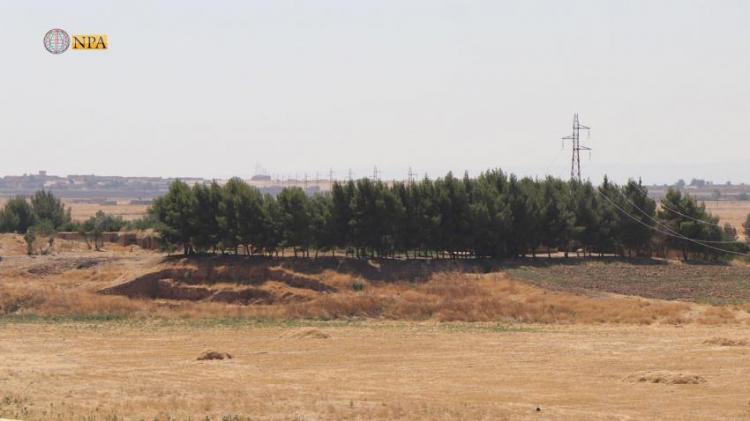Al-Jazira s oldest archaeological site under threat of disappearance
Hasakah- North-Press Agency
Delsoz Yousef
There are thousands of archaeological sites in Hasakah governorate in northeastern Syria, that have witnessed the succession of ancient civilizations that were present in that geographical area.
Perhaps the most prominent of these sites is “Sokar Al Ahemer Hill”, which is considered as one of the oldest archaeological sites in the region, but it’s marginalized and threatened to disappear, as concerned authorities in the region do not make a move to save this historical heritage.
The Site
“Sokar Al Ahemer Hill” is located about 7 km west of Tal Tamr, in the western countryside of Hasakah governorate, it’s oval in shape and dates back to 8000 BC, according to the Japanese expedition, where it is considered to be older than the archaeological site of Tal Halaf, which is located in Ras Al-Ain / Sare Kani area, northwest Hasakah, which dates back to 7,000 BC.
Rana Al-Asaad, an administrator at the Directorate of Antiquities Protection in Hasakah region (an administrative division that includes Hasakah city to Ras Al-Ayn on the Turkish borders), told North-Press that there are about 1043 archaeological sites in the al-Jazira region in northeastern Syria, while only 20 of them have been excavated so far, pointing out that “Sokar Al Ahemer” is one of the most important site.
Moreover, “Sokar Al Ahemer” was uncovered and documented in 1991 by a French expedition, before excavation works which were begun in 2000 by a Japanese expedition from the University of Tokyo headed by researcher Yoshihiro Nisaki, excavations continued until the outbreak of the Syrian crisis, as the Japanese expedition returned to their country until establishing stability in the region, and find a political solution in the country, according to what Asaad said.
Al-Asaad points out that the most important discoveries they found were “grain of wheat”, which confirms that agriculture was discovered in this area, they also found a statue of a woman and a well.
Furthermore, documents indicate that the Japanese expedition also discovered buildings established with stone made of clay, plastered floors, inside which were found archaeological plates made of flint and pottery, and these discoveries date back to the seventh millennium BCE.
Tools such as slabs, stone axes, blades and stone pots were also found, as well as pottery pieces from the Paleolithic period between 4500-3100 BC.
Al-Asaad says that these discoveries proved that the site dates back to the “Neolithic era,” indicating that the Japanese mission has excavated 30 percent of the hill so far.
According to researcher and university professor Yousuf Kenjo who confirmed in his book “One hundred archaeological sites in Syria”, that the culture of “Sokar Al Ahemer Hill” is linked to the culture of Taurus Mountains (one of the mountains known in the geography of Kurdistan located in the northern part of it), based on the type of the revealed houses.
With the outbreak of the Syrian crisis, the site was neglected, and with the introduction of the Democratic Autonomous Administration that manages northern and eastern regions of Syria, the Tourism and Antiquities Authority has deployed guards to prevent clandestine excavations at archaeological sites and keep them from being stolen.
However, the lack of a proper mechanism to protect the sites from weathering, and its marginalization by Autonomous Administration, made the site vulnerable to disappearance in the absence of site restoration works.
“We do communicate from time to time with the Japanese mission, where we take photos of the site and send them, to keep them updated with the latest situation of the site,” said Rana Al-Asaad, indicating that they do not have a specific mechanism to maintain the external appearance of the site, but their work is focused on preventing clandestine excavations of the site.

